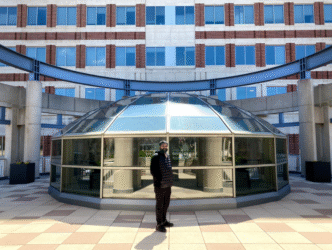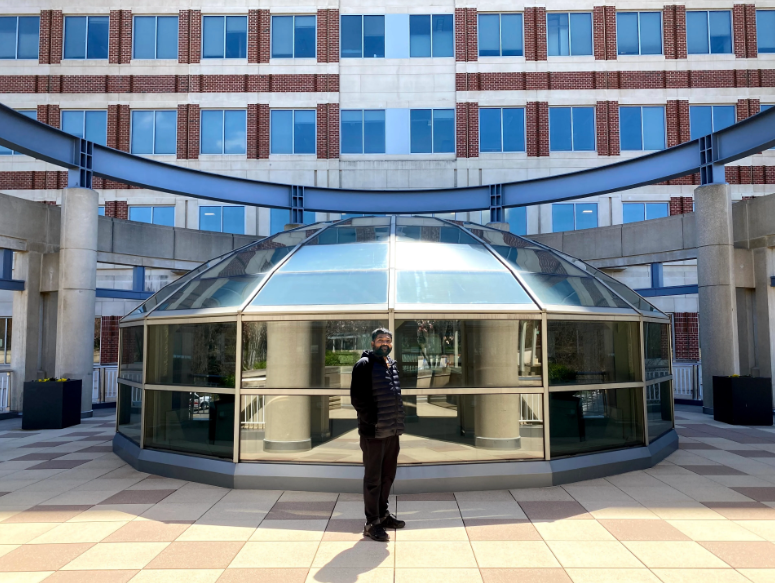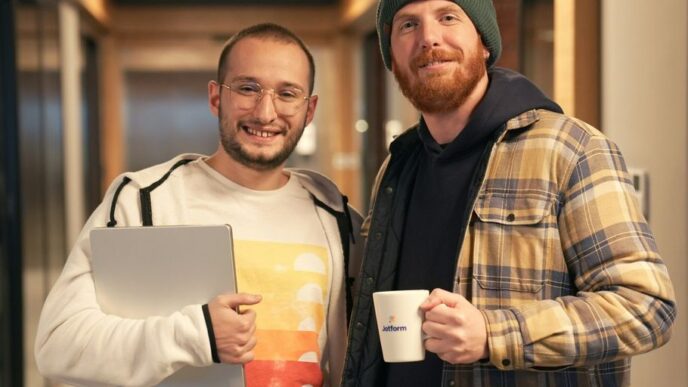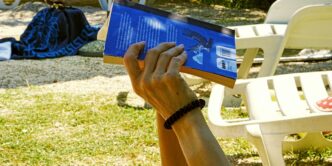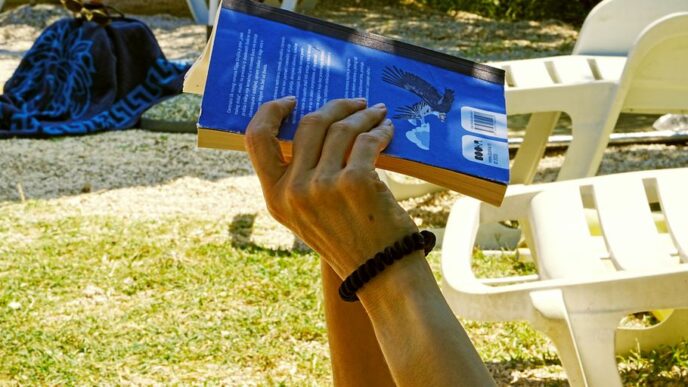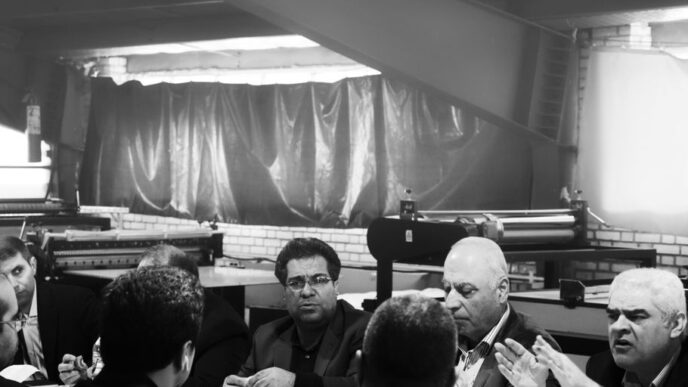(Gallery | SolarCleano) An autonomous robot cleans rows of solar panels in a desert solar farm, exemplifying the AI-driven maintenance technology championed by Kamisetty.
Reston, Virginia – Under the glare of a desert sun, an autonomous robot creeps methodically across a vast expanse of solar panels, brushing away dust that would otherwise sap their performance. High above in the breeze, a drone inspects the blade of a wind turbine for micro-cracks invisible to the naked eye. These futuristic scenes are fast becoming reality, thanks in no small part to Arjun Kamisetty, a pioneering technologist championing the use of artificial intelligence (AI) and robotics to maintain solar and wind installations. Kamisetty’s groundbreaking contributions are helping transform how the renewable energy industry keeps its critical infrastructure running efficiently – a mission that marries cutting-edge innovation with the urgent need for sustainability.
Transforming Solar and Wind Maintenance with AI and Robotics
Kamisetty’s recent research has spotlighted the profound impact intelligent machines can have on renewable energy operations. In a peer-reviewed study published last year, he demonstrated how AI-driven robots can drastically improve the upkeep of solar farms and wind turbines, leading to significant gains in reliability and green energy output. By deploying smart robots for routine inspections, cleaning, and repairs, operators can detect issues earlier and address them faster. “We have hundreds of thousands of solar panels and turbine blades out there in the field. To harness their full potential, we need tireless, precise systems looking after them,” Kamisetty said, underscoring the high stakes of proactive maintenance.
Traditional maintenance of renewable energy sites is labor-intensive and sometimes hazardous. Wind turbine blades, for instance, often require technicians to rappel down on ropes for close inspection or repairs – an arduous task that can only be done during calm weather (BladeBUG crawler robot shows promise in remotely inspecting wind turbine blades. – ASME). Drones have eased inspections from afar, but critical hands-on work still demands risking human lives at towering heights (BladeBUG crawler robot shows promise in remotely inspecting wind turbine blades. – ASME). Kamisetty’s work envisions a safer alternative: autonomous robots that can climb turbines or crawl across panel arrays, performing the dirty and dangerous jobs without complaint.
His study found that AI-guided robots could truly revolutionize maintenance by making it faster, safer, and more precise. Equipped with sensors and machine-learning algorithms, these robots can identify fine-grained defects or performance issues that humans might miss – from hairline cracks in a turbine blade to dust accumulation patterns on solar cells. The result is maintenance that happens before small glitches snowball into major outages, saving time and money while keeping energy flowing. Just as importantly, this high-tech approach advances sustainability goals: well-maintained equipment means more efficient output and less waste of resources.
Kamisetty’s research highlights several key benefits of AI-driven robotic maintenance:
- Higher efficiency and uptime: Robots can conduct inspections and fixes more frequently and accurately than humans, reducing downtime for wind and solar systems.
- Enhanced safety: Risky tasks like climbing turbine towers or cleaning vast solar arrays in harsh weather can be delegated to machines, keeping workers out of harm’s way.
- Resource savings: Intelligent automation ensures that maintenance is done exactly when needed, avoiding unnecessary repairs and minimizing waste, which supports sustainability efforts.
(BladeBUG crawler robot shows promise in remotely inspecting wind turbine blades. – ASME) A six-legged BladeBUG robot with suction pads clings to a wind turbine blade during a test, illustrating the new wave of robotic maintenance making wind farms safer and more efficient.
Kamisetty emphasizes that these improvements aren’t just theoretical. They are already being validated by emerging technologies in the field – from robots that “walk” along turbine blades to automated rovers that keep solar panels spotless. By integrating AI, these machines learn normal operating patterns and can flag anomalies in real time.
“The beauty of AI in this context is that it learns what ‘healthy’ means for a wind turbine or a solar panel. When something deviates, the robot knows it instantly and can alert us or even fix it on the spot,” he explained, illustrating how machine intelligence adds a crucial layer of vigilance to renewable energy assets.
Leadership Driving Innovation and Sustainability
Beyond the technical specifics, what sets Arjun Kamisetty apart is his vision for bridging technology and sustainability. Colleagues describe him as a tireless advocate for clean energy innovation – someone who speaks the language of both software and solar farms. In his roles as a researcher and engineer, Kamisetty has built a reputation for not only advancing AI and robotics, but doing so in service of a greener planet. His 2022 paper on AI-driven robotics for energy maintenance has been lauded as a roadmap for the industry, synthesizing insights from numerous case studies and trials into a clear strategy for the future. By combining data from academic research, real-world pilot projects, and industry reports, he mapped out where automation can make the biggest difference and how to implement it responsibly.
Kamisetty’s thought leadership shines through in the way he communicates these ideas. He often frames the conversation around climate action and long-term sustainability. “This isn’t just about cool robots or nifty AI algorithms – it’s about ensuring renewable energy can scale up dramatically,” he said. “If we can maintain solar and wind farms smarter, they can produce power at peak capacity for longer, and that’s a win for the planet.” Such statements underscore why Kamisetty is seen as a champion of the cause. He frequently mentors fellow engineers and engages with energy policymakers, helping to align cutting-edge tech development with environmental goals.
Importantly, Kamisetty recognizes that technology alone isn’t a silver bullet. He has been a vocal proponent of collaborative efforts that bring together the public and private sectors to support these advancements. In his study, he notes that despite the promising results, adoption of AI-driven maintenance faces hurdles – and overcoming them will require collective action.
Overcoming Hurdles on the Path to a Greener Future
Even as Kamisetty pushes the boundaries of innovation, he is candid about the challenges that must be addressed for AI-driven robotics to fully take hold in renewable energy maintenance. One major obstacle is cost. The sophisticated robots and drones don’t come cheap, and the upfront investment can be hard to swallow for smaller energy operators. “Deploying a robot on a wind farm is an investment – not every small operator has the budget of a big utility,” Kamisetty noted. However, he argues that costs will come down with time and scale, much as solar panels themselves plummeted in price over the past decade.
Harsh environments pose another test. Solar farms are often in deserts or open plains, and wind turbines soar hundreds of feet high, sometimes offshore in corrosive sea air. Designing robots that can withstand extreme heat, sandstorms, high winds, or saltwater spray is no small feat. Regulatory frameworks also need to catch up to technology. Rules governing drones and autonomous machines vary widely, and in some regions, complex regulations could slow the deployment of robotic systems on energy sites.
Kamisetty’s research calls for targeted strategies to tackle these barriers. He advocates for more research and development funding to refine these technologies and bring costs down, as well as clear industry standards and regulations to ensure safety without stifling innovation. Perhaps most crucially, he stresses the need for incentives that can help smaller renewable operators access advanced maintenance tools. Government grants or public-private partnerships could offset initial costs, making high-tech solutions accessible across the industry.
He distills these challenges and solutions into a few key points:
- Investment and cost reduction: Increase R&D and implement incentives so that even modest renewable energy providers can afford cutting-edge maintenance robots.
- Technological resilience: Engineer robots for durability in extreme weather and tough conditions, ensuring they can reliably operate anywhere turbines spin or panels glint.
- Policy and collaboration: Develop consistent regulations for autonomous systems and encourage cooperation between governments, industry leaders, and researchers to accelerate safe adoption.
Kamisetty is optimistic that these hurdles can be overcome. He points out that renewable energy itself was once considered too expensive and niche, yet today it’s a mainstream part of the power mix thanks to concerted efforts. In the same way, he envisions intelligent maintenance robots becoming standard tools of the trade in the near future. “We’re at a tipping point where AI and robotics can fundamentally boost renewable energy’s effectiveness. But to get there, everyone – engineers, policymakers, investors – has to pull in the same direction,” he said, reiterating the collaborative ethos that underpins his approach.
Pioneering a Sustainable Energy Future
As the world races to curb carbon emissions and transition to clean power, the importance of maximizing every solar panel and wind turbine cannot be overstated. Arjun Kamisetty’s work is a testament to how innovation can answer that call. By championing AI-driven robotics for maintenance, he is not only solving practical engineering problems but also strengthening the backbone of a sustainable energy future.
His leadership in this arena has started to ripple outward. Industry observers credit Kamisetty with helping to accelerate a trend that could make renewable energy systems more autonomous and reliable than ever. In turn, this boosts investor confidence in green infrastructure and reassures the public that wind and solar power can be dependably integrated into daily life. Kamisetty stands at the forefront of this movement, blending visionary thinking with hands-on problem-solving.
Looking ahead, Kamisetty remains both realistic and hopeful. He is the first to admit that integrating AI into physical industries is complex, yet he draws inspiration from the progress made so far. A few years ago, the idea of robots routinely scrambling over turbine blades or patrolling solar farms seemed like science fiction; now it’s on the cusp of routine deployment. “The future of renewable energy isn’t just about building more turbines or panels,” Kamisetty observed in a recent talk. “It’s about making sure the ones we have are smarter, more resilient, and ready to carry us into a greener future.”
With innovators like Arjun Kamisetty leading the charge, that future is arriving faster than ever – one robot, one panel, and one turbine at a time.
Sources: Arjun Kamisetty’s research publication on AI-driven robotics in renewable energy maintenance; industry insights on wind turbine robotics (BladeBUG crawler robot shows promise in remotely inspecting wind turbine blades. – ASME).

